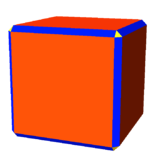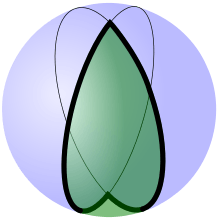Digon
| Regular digon | |
|---|---|
 On a circle, a digon is a tessellation with two antipodal points, and two 180° arc edges. | |
| Type | Regular polygon |
| Edges and vertices | 2 |
| Schläfli symbol | {2} |
| Coxeter diagram |
|
| Symmetry group | D2, [2], (*2•) |
| Dual polygon | Self-dual |
In geometry, a digon is a polygon with two sides (edges) and two vertices. Its construction is degenerate in a Euclidean plane because the two sides would either coincide or one or both would have to be curved.
A regular digon has both angles equal and both sides equal and is represented by Schläfli symbol {2}. It may be constructed on a sphere as a pair of 180 degree arcs connecting antipodal points, when it forms a lune.
The digon is the simplest abstract polytope of rank 2.
A truncated digon, t{2} is a square, {4}. An alternated digon, h{2} is a monogon, {1}.
In Euclidean geometry
A straight-sided digon is regular even though it is degenerate, because its two edges are the same length and its two angles are equal (both being zero degrees). As such, the regular digon is a constructible polygon.[1]
Some definitions of a polygon do not consider the digon to be a proper polygon because of its degeneracy in the Euclidean case.[2]
In elementary polyhedra

A digon as a face of a polyhedron is degenerate because it is a degenerate polygon. But sometimes it can have a useful topological existence in transforming polyhedra.
As a spherical lune
A spherical lune is a digon whose two vertices are antipodal points on the sphere.[3]
A spherical polyhedron constructed from such digons is called a hosohedron.
 A lune on the sphere.
A lune on the sphere. Six digon faces on a regular hexagonal hosohedron.
Six digon faces on a regular hexagonal hosohedron.
Theoretical significance
The digon is an important construct in the topological theory of networks such as graphs and polyhedral surfaces. Topological equivalences may be established using a process of reduction to a minimal set of polygons, without affecting the global topological characteristics such as the Euler value. The digon represents a stage in the simplification where it can be simply removed and substituted by a line segment, without affecting the overall characteristics.
The cyclic groups may be obtained as rotation symmetries of polygons: the rotational symmetries of the digon provide the group C2.
See also
References
Citations
- ↑ Eric T. Eekhoff; Constructibility of Regular Polygons, Iowa State University. (retrieved 20 December 2015)
- ↑ Coxeter (1973), Chapter 1, Polygons and Polyhedra, p.4
- ↑ Coxeter (1973), Chapter 1, Polygons and Polyhedra, pages 4 and 12.
Bibliography
- Herbert Busemann, The geometry of geodesics. New York, Academic Press, 1955
- Coxeter, Regular Polytopes (third edition), Dover Publications Inc, 1973 ISBN 0-486-61480-8
- Weisstein, Eric W. "Digon". MathWorld.
- A.B. Ivanov (2001), "Digon", in Hazewinkel, Michiel, Encyclopedia of Mathematics, Springer, ISBN 978-1-55608-010-4
External links
| Look up digon in Wiktionary, the free dictionary. |
 Media related to Digons at Wikimedia Commons
Media related to Digons at Wikimedia Commons